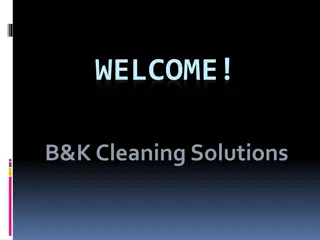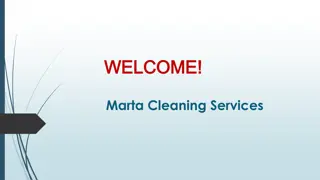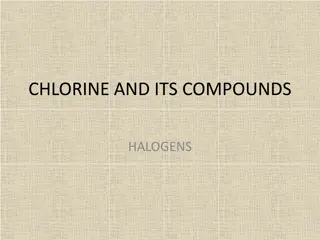Understanding Bleach and Chlorine Compounds in Cleaning
Bleach and chlorine compounds are commonly used disinfectants with varying concentration ranges. They are effective at killing bacteria, fungi, and viruses, but require specific pH and concentration levels for optimal performance. Chlorine gas is particularly useful for sanitizing enclosed systems. However, these chemicals can be corrosive and should be handled carefully to avoid toxic gas releases when mixed with incompatible substances. Factors such as temperature, light exposure, and storage time can impact their disinfection efficacy.
Download Presentation

Please find below an Image/Link to download the presentation.
The content on the website is provided AS IS for your information and personal use only. It may not be sold, licensed, or shared on other websites without obtaining consent from the author. Download presentation by click this link. If you encounter any issues during the download, it is possible that the publisher has removed the file from their server.
E N D
Presentation Transcript
MODULE 6 BLEACH AND OTHER CHLORINE COMPOUNDS T h i s m a t e r i a l w a s p r o d u c e d u n d e r g r a n t n u m b e r S H - 0 5 0 4 6 - S H 8 f r o m t h e O c c u p a t i o n a l S a f e t y a n d H e a l t h A d m i n i s t r a t i o n , U . S . D e p a r t m e n t o f L a b o r. I t d o e s n o t n e c e s s a r i l y r e f l e c t t h e v i e w s o r p o l i c i e s o f t h e U . S . D e p a r t m e n t o f L a b o r, n o r d o e s t h e m e n t i o n o f t r a d e n a m e s , c o m m e r c i a l p r o d u c t s , o r o r g a n i z a t i o n s i m p l y e n d o r s e m e n t b y t h e U . S . G o v e r n m e n t . 1
WHAT IS BLEACH? Bleach is a water-based solution commonly used as a disinfectant. There are various concentration ranges of bleach used. How does it work? o Effective at killing bacteria, fungi, and viruses. o Final solution should be 0.5 to 2.0% (5,000-20,000 ppm) sodium hypochlorite Disadvantage: o bleach solutions for disinfection MUST be made up daily. 2 Picture: www.maxpixel.net/Bleach-Detergent-Laundry-147520
CHLORINE COMPOUNDS Chlorine compounds o Range of concentrations, requiring 1-10 minutes of contact time o Hypochlorites of potassium, sodium or calcium 115 3
CHLORINE GAS USAGE Chlorine gas especially useful as a sanitizer for cleaned in place (CIP) applications (inside of pipes, enclosed systems) 4
WHAT ARE THE ADVANTAGES OR DISADVANTAGES OF CHLORINE CHEMICALS? Advantage o All are effective sanitizers for clean stainless steel food contact surfaces o Disadvantages o User needs to ensure proper pH and concentration levels. o All can be highly corrosive o All produce corrosive gas above 115 F. 5
WHAT AFFECTS HOW WELL THESE CHEMICALS DISINFECT? Temperature Exposure to light How long it is stored Bleach solutions react with organic matter and becomes less effective 6
OTHER ISSUES OF USING BLEACH Disadvantages of bleach? o Bleach is incompatible with many other chemicals. o Mixing bleach with ammonia releases toxic gases o Mixing bleach with acid releases chlorine gas! 7
WHAT ARE THE POTENTIAL HEALTH HAZARDS ASSOCIATED WITH BLEACH AND CHLORINE CHEMICALS? Chlorine chemicals, including bleach, are eye irritants and lung irritants After accidentally inhaling the fumes, some people feel stinging in their nose and eyes, coughing, and lightheadedness, all symptoms of the corrosiveness of the chemical. If left on surfaces for a long period of time, including skin, it can cause irritation and burning. 8























